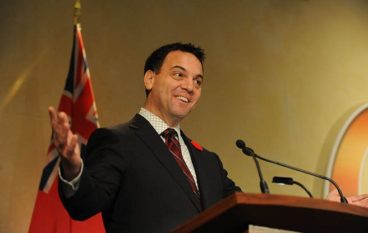Economists say Tim Hudak’s “million jobs” promise is probably a math error

Politicians “create jobs” the same way homeopathic medicines treat cancer—which is to say, they almost definitely don’t at all, but a certain percentage of the population will never be convinced of that. Political change can nudge job numbers in the right direction, but the economy, like the human body, is too big and complex to respond predictably to tiny doses of cure. And so Ontario Progressive Conservative leader Tim Hudak’s “Million Jobs Plan” has been highly suspect from day one. What’s more, economists are now saying that it may be flawed to the point of utter uselessness, largely because of a single mathematical error.
The skepticism is traceable to a recent David Reevely column in the Ottawa Citizen, in which Reevely points out that the number of jobs the Ontario PC party claims its policies will create doesn’t match those predicted by Benjamin Zycher, a right-wing U.S. economist commissioned by the party. A couple weeks later, Jim Stanford, a Canadian economist, wrote a blog post that studied the “million jobs” claim in more detail. According to Stanford’s analysis, the Tories may have drastically overestimated the employment impact of their proposed job-creation policy because of a fundamental misunderstanding of the difference between a permanent job and what’s known as a “person-year” of employment. (A person-year is an economic unit of measurement equal to one year of work for one person. So, one guy working one job for two years would account for two person-years of employment.)
By confusing person-years with jobs, Stanford says the PC party’s policy wonks effectively counted each new position eight times over, meaning around 200,000 of the promised one million jobs are completely fictional. And that’s before factoring in the impact of the 100,000 job losses that would occur if Hudak were to make good on his promise to cut public-sector employment in the province. All things considered, Stanford figures Hudak’s potential job impact at virtually nil. Writing in Maclean’s, Western University business professor Paul Boothe pegged the real job-creation number at 75,000. According to the Globe, McMaster University economist Michael Veall reviewed Hudak’s numbers and came to a similar conclusion. And all of this is assuming the numbers the PC party based its claims on—drawn from reports by Zycher and the Conference Board of Canada—were even accurate to begin with.
The lesson here, if there is one, is simple: if you’re going to use sketchy job-creation numbers, at least make sure you’re interpreting them right.






I don’t even know if this rises to the level of a “mathematical error.” Mistaking a person-year of employment for a job is a lot like mistaking an apple for a box of apples. I wouldn’t call that math so much as reading comprehension.
Math doesn’t matter to Hudak. It’s all about how good it sounds, and a million sounds good.
Hudak’s plan has more merit that the Liberal plan to grow payroll tax or implement a provincial pension plan. Asking employers to commit more to payroll tax will really result in a downturn in hiring. The opposition is more bent on dissing the Hudak plan but it has far more merit than anything from either left wing party. If the math of the Liberals is more acurate than Hudaks, why is the province sinking into an abyss of debt from which there may never be a recovery?
The “abyss” of debt is so unrecoverable Ontario has an international double A credit rating. You also forgot to mention that tiny little thing called the great recession the Liberals created. Actually that was created by right-wing style “free market” deregulation in the US. You’re long on hyperbole and short on reality, like Hudak himself.
Quick Tea Party Tim, say mathematics is a liberal conspiracy !
A down turn in hiring huh…Hudak is imitating Scott Walker’s talking points and plan to a tee. What happened to Wisconsin under Walker?… It is now virtually the lowest job creator out of all the Midwest states !
Reminds me of another right wing nutter who claims he saved the tax payers a billion dollars.
The math in this article doesn’t even add up. It says that only 200,000 of the 1,000,000 jobs are fictional and that only 100,000 pointless public sector would go. Which leaves a net positive of 700,000 new jobs. So how did they end up with 75,000? Shouldn’t the title of the article be “Economists believe Tim Hudak’s “million jobs” promise will lead to an 700,000 job increase”